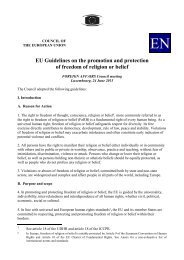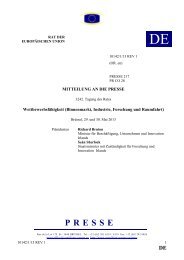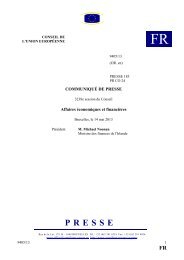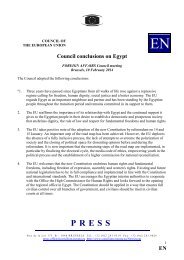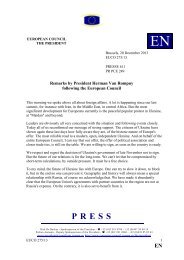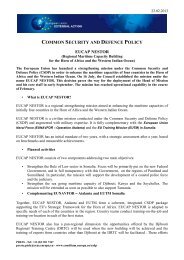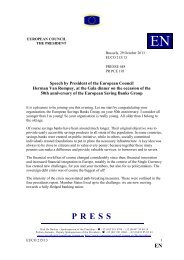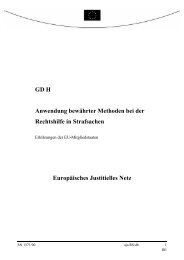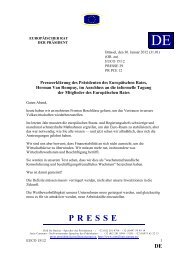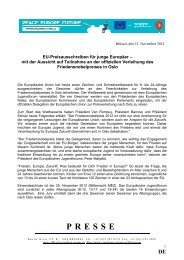14508/09 ADD 1 PL/vk 1 DG G COUNCIL OF THE ... - Europa
14508/09 ADD 1 PL/vk 1 DG G COUNCIL OF THE ... - Europa
14508/09 ADD 1 PL/vk 1 DG G COUNCIL OF THE ... - Europa
Create successful ePaper yourself
Turn your PDF publications into a flip-book with our unique Google optimized e-Paper software.
parliaments (76 % men, 24 % women). In general, countries with higher levels of female<br />
representation in national parliaments also have higher levels of female representation in national<br />
governments. However, there are great differences between the MS. In 2008, while Finland had a<br />
majority of female ministers (60 %), Spain had parity (50 %), three countries had 40 % women or<br />
more in their national governments (SE, BE, DE), and three MS had less than 10 % women<br />
(CY, SK and RO).<br />
At the European Commission, the number of female commissioners has increased significantly.<br />
Since the first women Commissioner was appointed in 1988, the present Commission (June 20<strong>09</strong>)<br />
is comprised of 10 women (37 %) and 17 men (63 %), the best ever in terms of women's numerical<br />
representation.<br />
Indicator 6: The number of women and men senior/junior ministers in different fields of action can<br />
be categorized according to the functions of the respective minister. In the Database on Women and<br />
Men in Decision-Making, the BEIS typology describes this aspect of political power and refers to<br />
four types of state functions: 1). Basic functions (foreign and internal affairs, defence, justice, etc.),<br />
2). Economic functions (finance, trade, industry, agriculture, etc.), 3). Infrastructure (traffic,<br />
communication, environment, etc.), and 4). Socio-cultural functions (social affairs, health, children,<br />
family, youth, elderly people, education, science, culture, labour, sports, etc.).<br />
When it comes to the number of women and men senior/junior ministers by field of action,<br />
differences between the sexes are to be found primarily in the field of socio-cultural and basic<br />
functions (table 4.7.2). A majority of the female ministers (40.5 %) represents the field of socio-<br />
cultural functions, and a minority of them (17.5 %) represents the field of economic functions. A<br />
little bit more than a fourth of them (28 %) are represented in the basic functions. In contrast, a<br />
majority of the male ministers (41 %) are represented in basic functions and one fourth of them are<br />
represented in economic functions (26 %), while a minority of them are represented in the socio-<br />
cultural functions (20 %). Women and men are similarly represented in field of infrastructure (12 %<br />
of women, 13 % of men).<br />
<strong>14508</strong>/<strong>09</strong> <strong>ADD</strong> 1 <strong>PL</strong>/<strong>vk</strong> 101<br />
ANNEX <strong>DG</strong> G EN



